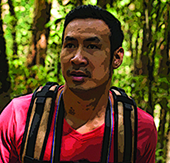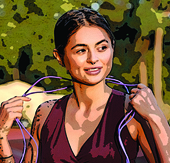

 |
 |
 |
 |
 |
  |
DAY 5 –The route to Sigurwana delivers stunning views and historic treasures
The group had an early-morning start. The temptation to spend some more time at Leshiba’s Luvhondo camp was great, but the hikers knew that the day was going to be a long one. They had to get to Sigurwana Lodge, more than 15 kilometres to the west, but it also meant traversing the beautiful Hamasha Gorge.
A quick breakfast, served with strong coffee, was a tonic for any sore body and the hikers were in an exceptionally cheerful mood.
The first stretch of the journey was relatively easy and took them across the Leshiba plains. The sight of a herd of giraffe slowly making their way into the deeper bush while the sun rose made the early wake-up call worth the while.
Initially the trail followed the existing game tracks, but then it joined the cycling trail.
“If only I had my mountain bike,” lamented Zachary.
“Now you’re talking,” Lee joined in.
The cycling trail takes riders on a circle route through Leshiba, with some breath-taking views. Marelize looked at them two with an annoyed frown. She was not a big fan of mountain biking after having had some nasty falls earlier in her life.
The trail took them along some open plains before they left the cycling trail and headed into an area called Bushman’s Medicine Chest. Edwin showed them some of the medicinal plants that were native to the area and used to cure all sorts of ailments.
The previous day’s discussion on the rock art was still fresh in the minds of the hikers and Edwin decided to show them a shelter not far from the route that had more paintings. The differences between the San and Khoekhoe paintings were easier to distinguish here than at the previous setting. Some artifacts could also be identified.
The visit to the rock shelter was short, as the group members had to make their way down the dense forest towards Hamasha Gorge. They stopped at a viewpoint on the ridge, which provided a great view for looking down into the gorge before heading down through the forest to some rocky slabs and the river at the bottom.
This was a very technical part of the trail, with steep, angled rocks, multiple stream crossings, and boulder-hopping in a streambed to navigate. However, the effort was incredibly rewarding, with the most spectacular and dramatic landscape unfolding before the hikers.
After passing a rock pool, the trail headed up ‘The Slabs’ – big, red rock slabs that sloped steeply down towards the stream. The hikers needed to traverse multiple slabs, which required walking up the gorge at an angle. At the top of the slabs, the trail headed back into a beautiful riverine forested section and a welcome lunch stop next to the stream.
It was while crossing the stream that Taki noticed the blue bead.
“Look what I found,” she called out excitedly while having a closer look at the bead. At first, it looked like a blueish stone, but the hole in the middle indicated that this was man-made. Taki could also spot that it was made of glass.
“You are incredibly lucky to have found one, but these beads are actually not so uncommon in the area,” Edwin explained. “Glass beads were highly prized by African communities for use as everyday adornment, ceremonial costumes, or objects of barter. My guess would be that this is a Zhizo bead, but you would have to get it analysed by someone with a lot more knowledge than I have,” he added.
The discovery of the bead caused a surge of excitement, and everyone wanted to have a look at the artefact. It was passed on from one to another, mimicking the way such beads made their way all over the world, being passed on from one trader to another in exchange for goods.
“Who were the Zhizo?” asked Marelize, rolling the bead between her fingers.
“It is estimated that the Zhizo people settled in the Limpopo-Shashe basin around 900 AD. Excavations done at places such as Schroda produced glass beads like the one you have found. The beads are evidence of trade between the local inhabitants and the outside world, most notably via the Indian Ocean,” Edwin explained.
While the buzz continued, the group members settled down next to the stream for lunch. Everyone was noticeably scouring the ground carefully in search of more beads.
Adrian found a spot on a rock, a few metres away from the group. His turn to talk about his scar had arrived, and the normally talkative man was not looking forward to it.
Click here to read Adrian's story
Information sourced from:
https://www.ewt.org.za/old-salt-trail-description-slackpacker/
DAY 5 – Exploring the forest to reach Sigurwana Lodge
The group of hikers reluctantly left the spot at the stream where they had enjoyed lunch. Taki’s discovery of an historic glass bead made them more attentive of what they were stepping on. Suddenly they became aware of little lizards, the different types of shongololos (millipedes) and the vast array of spiders present in the area.
Sigurwana Lodge, where they were heading, was towards the west, away from the stream. The long, rocky trail traversing beautiful mountain bushveld provided some stunning views of the landscape below. Far below they could see the route they had travelled, coming from Leshiba’s Luvhondo Camp.
The trail then entered Sigurwana, and the hikers left the mountainous route to cross beautiful grasslands and open savannah. The final stretch of the trail dropped down on a fairly steep, yet short, descent into a small gorge below Sigurwana Lodge and the most beautiful Waterberry forest next to a stream.
“Another waterfall!” Marelize shouted excitedly as they entered the forest and she spotted the deep pool, just waiting for someone to dip their tired feet in.
“The trees are absolutely amazing. How many species would there be,” Lee asked.
“From what I have heard, the Soutpansberg is host to at least a third of all the known tree species in the entire southern African region. A highly respected local researcher, Norbert Hahn, has recorded almost 600 trees and shrubs in the mountain. To put this into perspective - the Kruger National Park, which covers an area of two million hectares, contains approximately 380 tree species. Norbert has recorded 321 tree species in an area of only 2 000 hectares within the Soutpansberg Conservancy,” Edwin explained.
“And don’t forget – where there are trees and shrubs, you will find birds,” Zachary commented. While still speaking, he took out his phone and opened his favourite bird app. “I read somewhere that the Soutpansberg mountain range plays host to more than 500 bird species. Do you guys realise that approximately 56% of the recorded bird species for the entire southern Africa can be spotted here?” he asked, looking chuffed with supplying this bit of info.
Gerrit mumbled something about “techno junkies and their gadgets”, shaking his head.
After stopping at the waterfall and admiring the beauty of the forest for a few minutes, the group got back on the trail. The lodge was not far away, and after a scramble up a rocky ledge and some more stream-hopping, they reached the lodge, where they were met by the friendly Sigurwana staff.
The name “Sigurwana”, they were told, means “Close to Heaven” and after a long day of hiking, this could not be a more accurate description. The 5 500 hectare of wilderness area on top of the Soutpansberg is probably as close to paradise as nature lovers could expect - a botanical treasure chest that includes an ancient forest and rare cycads.
The hikers were escorted to their sleeping quarters for a quick rest. After supper, they gathered around the fireplace. Time for another story, and tonight Gerrit had the platform. Thus far he had been evading the attention, very conveniently not being close enough when the opportunity to tell stories arose. Tonight, however, he would have no choice but to tell the group about his scars.
Click here to view Gerrit's story
Sources:
https://repository.up.ac.za/bitstream/handle/2263/23251/04chapter4.pdf?sequence=5
https://www.ewt.org.za/old-salt-trail-description-slackpacker/
Meet the adventurers:
 |
Our narratorMarelize (27) is the narrator of the story. She is a seasoned traveller and has visited countries in Europe and the USA. |
|
Rovha is a soft-spoken dentist with smiling eyes. He is a loner and can often be found in a quiet corner reading a book or newspaper. |
 |
 |
Gerard is a Dutch adventure tourist. At 66 he has retired from the university he has been teaching at. He now spends his time travelling. |
|
Zachary (39) is a geologist. His insatiable thirst for adventure has taken him on many dangerous trails and earned him the title of Bear Grylls. |
 |
 |
Lee (28) has never let her neurological disorder become a disablity. Although physically strong, she has a emotional scar she hides well. |
|
Emma is a 37-year-old award-winning journalist who is currently working for a local newspaper but aspires to be a war photographer. |
 |
 |
Shabnim's small stature may be deceiving but at age 42, she is a tough adventurer and a well-respected lecturer at a local university. |
|
Adrian is a boisterous character who enjoys controlling the conversation. He usually leads the pack and shares his expertise freely. |
|
 |
With a military background, Gerrit (55) was a captain in the old South African Army. He has seen the horrors of war and still runs from it. |
|
For the vibrant and energetic 25-year-old Takalani (Taki) nursing has always been |
 |
 |
Lisa (53) is the mother of two grown daughters and the wife of a wealthy CEO who travels a lot. Lisa has taken up hiking to fill her days. |






